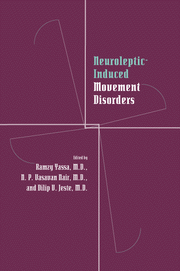Book contents
- Frontmatter
- Contents
- Contributors
- Preface
- Part I Historical perspective
- Part II Clinical aspects of tardive dyskinesia
- Part III Mechanisms underlying tardive dyskinesia
- Part IV Measurement of tardive dyskinesia
- Part V Tardive dyskinesia in different populations
- Part VI Other neuroleptic-induced movement disorders
- Part VII Treatment of tardive dyskinesia
- 28 Development of novel antipsychotic drugs with reduced extrapyramidal side effects
- 29 GABAergic treatments for tardive dyskinesia
- 30 Using biofeedback to train suppression of the oral-lingual movements of tardive dyskinesia
- Index
29 - GABAergic treatments for tardive dyskinesia
from Part VII - Treatment of tardive dyskinesia
Published online by Cambridge University Press: 09 October 2009
- Frontmatter
- Contents
- Contributors
- Preface
- Part I Historical perspective
- Part II Clinical aspects of tardive dyskinesia
- Part III Mechanisms underlying tardive dyskinesia
- Part IV Measurement of tardive dyskinesia
- Part V Tardive dyskinesia in different populations
- Part VI Other neuroleptic-induced movement disorders
- Part VII Treatment of tardive dyskinesia
- 28 Development of novel antipsychotic drugs with reduced extrapyramidal side effects
- 29 GABAergic treatments for tardive dyskinesia
- 30 Using biofeedback to train suppression of the oral-lingual movements of tardive dyskinesia
- Index
Summary
Although the pathophysiology of tardive dyskinesia remains unknown, recent experiments have supported the possibility of a mechanism of transmission involving γ-aminobutyric acid (GABA). The earlier dopamine hypothesis of tardive dyskinesia was based on the development of dopamine receptor supersensitivity following long-term neuroleptic treatment. However, the hypothesis of dopamine receptor supersensitivity was inconsistent with certain clinical and experimental data, and adjustments to the hypothesis were made over the years. The more recent explanation is that following a cascade of neurophysiological changes upstream, there is diminished GABAergic efferent activity coming from the basal ganglia. This better fits the evidence than did the simple dopamine hypothesis. It seems, therefore, that GAB A mimetics may reduce dyskinetic symptoms by enhancing GABAergic efferent activity from the basal ganglia.
Dopamine Receptor Supersensitivity Hypothesis
The dopamine receptor supersensitivity hypothesis has been widely cited as the pathophysiological mechanism in tardive dyskinesia. The supporting evidence is chiefly pharmacologic and includes findings such as the following: Dopamine agonists exacerbate dyskinesia; dopamine antagonists (e.g., haloperidol) and dopamine depleters (e.g., reserpine) ameliorate dyskinesia; withdrawal of neuroleptics, exposing supersensitive dopamine receptors, temporarily exacerbates dyskinesia. Moreover, studies have shown that cholinergic stimulation, believed to oppose dopamine in the basal ganglia, reduces some dyskinetic symptoms. Nevertheless, several clinical observations remain unexplained by the dopamine receptor supersensitivity hypothesis. For example, although it is known that neuroleptics will induce striatal dopamine receptor supersensitivity in all human brains (Mackay et al., 1982; Rupniak, Jenner, & Marsden, 1985), only some patients will develop tardive dyskinesia.
- Type
- Chapter
- Information
- Neuroleptic-induced Movement DisordersA Comprehensive Survey, pp. 454 - 469Publisher: Cambridge University PressPrint publication year: 1996
- 1
- Cited by



